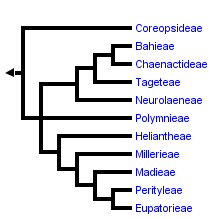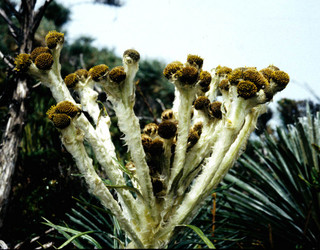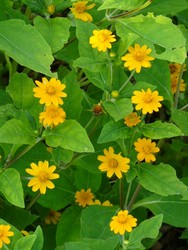Phytomelanic Cypsela Clade
Jose L. Panero


This tree diagram shows the relationships between several groups of organisms.
The root of the current tree connects the organisms featured in this tree to their containing group and the rest of the Tree of Life. The basal branching point in the tree represents the ancestor of the other groups in the tree. This ancestor diversified over time into several descendent subgroups, which are represented as internal nodes and terminal taxa to the right.

You can click on the root to travel down the Tree of Life all the way to the root of all Life, and you can click on the names of descendent subgroups to travel up the Tree of Life all the way to individual species.
For more information on ToL tree formatting, please see Interpreting the Tree or Classification. To learn more about phylogenetic trees, please visit our Phylogenetic Biology pages.
close boxChloroplast DNA phylogeny after Panero (2007).
Introduction
The Phytomelanic Cypsela Clade (PCC) contains approximately 5400 species in 460 genera classified in 11 tribes. All species of this clade have cypselae with a layer of phytomelanin that imparts a brownish black or black color to the fruit. Most species are endemic to the New World. They represent approximately half of the species of sunflowers in the Western Hemisphere and nearly one quarter of all species in the family. Most members of the group are annual or perennial herbs but shrubs and even trees are also well represented, especially in the Neotropics. Most species can be found in seasonally dry habitats. Spring ephemerals are important components of the desert floras of North America, whereas shrubby and arborescent members are mostly found in the extensive pine-oak forests of Mexico and scattered throughout the Andean forests of tropical South America and central Brazil.
References
Panero, J. L. 2007. Compositae: key to the tribes of the Heliantheae alliance. Pages 391-395 in Families and Genera of Vascular Plants, vol. VIII, Flowering Plants, Eudicots, Asterales. Kadereit, J. W., C. Jeffrey (eds.), Springer-Verlag, Berlin.
Panero, J. L., and V. A. Funk. 2008. The value of sampling anomalous taxa in phylogenetic studies: major clades of the Asteraceae revealed. Mol. Phylogenet. Evol. 47: 757-782.
Title Illustrations

| Scientific Name | Helianthus annuus |
|---|---|
| Location | Fargo, North Dakota |
| Creator | Photograph by Bruce Fritz |
| Source | Image Number K5751-1 |
| Source Collection | Agricultural Research Service Image Gallery |
| Scientific Name | Ruilopezia jahnii |
|---|---|
| Location | Venezuela. Táchira: Páramo Portachuelo |
| Comments | Monocarpic species of the paramos of westernmost Venezuela |
| Sex | Functionally staminate and pistillate florets |
| Life Cycle Stage | Flowering |
| Body Part | Flowering branch |
| Size | Approximately 0.5-1 m tall including capitulescence |
| Collection | TEX, MY |
| Collector | Panero, Benitez de Rojas, and Badillo |
| Copyright | © 2004 |
| Scientific Name | Melampodium paludosum |
|---|---|
| Location | cultivated, South Miami, Florida, USA |
| Specimen Condition | Live Specimen |
| Source | Melampodium paludosum |
| Source Collection | Flickr |
| Image Use |
 This media file is licensed under the Creative Commons Attribution License - Version 2.0. This media file is licensed under the Creative Commons Attribution License - Version 2.0.
|
| Copyright | © 2007 Scott Zona |
About This Page
Jose L. Panero

University of Texas, Austin, Texas, USA
Correspondence regarding this page should be directed to Jose L. Panero at
Page copyright © 2011 Jose L. Panero
 Page: Tree of Life
Phytomelanic Cypsela Clade.
Authored by
Jose L. Panero.
The TEXT of this page is licensed under the
Creative Commons Attribution-NonCommercial License - Version 3.0. Note that images and other media
featured on this page are each governed by their own license, and they may or may not be available
for reuse. Click on an image or a media link to access the media data window, which provides the
relevant licensing information. For the general terms and conditions of ToL material reuse and
redistribution, please see the Tree of Life Copyright
Policies.
Page: Tree of Life
Phytomelanic Cypsela Clade.
Authored by
Jose L. Panero.
The TEXT of this page is licensed under the
Creative Commons Attribution-NonCommercial License - Version 3.0. Note that images and other media
featured on this page are each governed by their own license, and they may or may not be available
for reuse. Click on an image or a media link to access the media data window, which provides the
relevant licensing information. For the general terms and conditions of ToL material reuse and
redistribution, please see the Tree of Life Copyright
Policies.
- First online 04 April 2008
- Content changed 11 July 2011
Citing this page:
Panero, Jose L. 2011. Phytomelanic Cypsela Clade. Version 11 July 2011 (under construction). http://tolweb.org/Phytomelanic_Cypsela_Clade/22911/2011.07.11 in The Tree of Life Web Project, http://tolweb.org/











 Go to quick links
Go to quick search
Go to navigation for this section of the ToL site
Go to detailed links for the ToL site
Go to quick links
Go to quick search
Go to navigation for this section of the ToL site
Go to detailed links for the ToL site